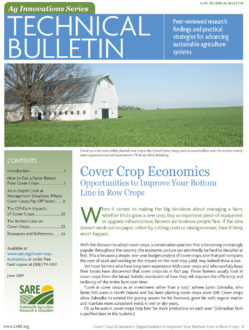
Mike Taylor, Helena, Ark.
Primary cover crops: cereal rye and mixes
A sign hangs in Mike Taylor’s shop that reads, “You do not inherit the land from your ancestors, you borrow it from your children.” Taylor and his father vividly remember 1992 as a year that challenged that statement. High wind conditions combined with their light, sandy soils resulted in sandblasting and a near-total loss of their cotton crop. The following year they began adding cover crops into their cotton rotation to keep their soil in place, and their use of cover crops has increased every year since. Cover crops are now normally used on 90% of their roughly 4,000 acres of row crops in east Arkansas near Helena. “I want my ground to be there for my kids,” Taylor says.
Taylor plants cereal rye as his cover crop of choice in their corn, soybean, peanut and cotton rotation, but he has incorporated blends as well and has even made use of 12- and 13-way mixes. He primarily seeks to prevent soil erosion and promote root growth below the soil surface. Cover crops have also helped to control herbicide-resistant Palmer amaranth and horsetail (marestail) on the farm.
For producers in his region considering a cover crop, Taylor advises to “drill it in and plant early.” He has tried many options for planting but prefers his no-till drill because it allows him to cut back his seeding rate and he always gets a stand. Taylor has seen producers who plant too late and terminate too early to receive maximum benefits, making their cover crops less profitable. In 2018, Taylor had some issues with slugs for the first time and is searching for a cost-effective remedy if they recur.
Taylor likes to point out that many people focus on annual expenses and potential savings with cover crops, but one area that has not received the same amount of attention is the change in equipment needs. To address his hardpan issues, Taylor drills cover crops instead of running a subsoiler tillage tool, thereby avoiding the fuel and labor cost associated with using his high-horsepower tractor. “I look at my no-till drill as my subsoiler,” he says.
Taylor also notes that cover crops seem to resolve the soil crusting issues they historically had. Thus, they rarely need to run their rotary hoe. A trackhoe implement, which was purchased years earlier to dig out eroded soil that filled up drainage ditches, is now seldom needed since cover crops have significantly reduced erosion on his fields. The machinery cost savings and better weed control have positively impacted his bottom line and help justify his effort to increase soil health, ensuring his children will have the same opportunity to farm.
